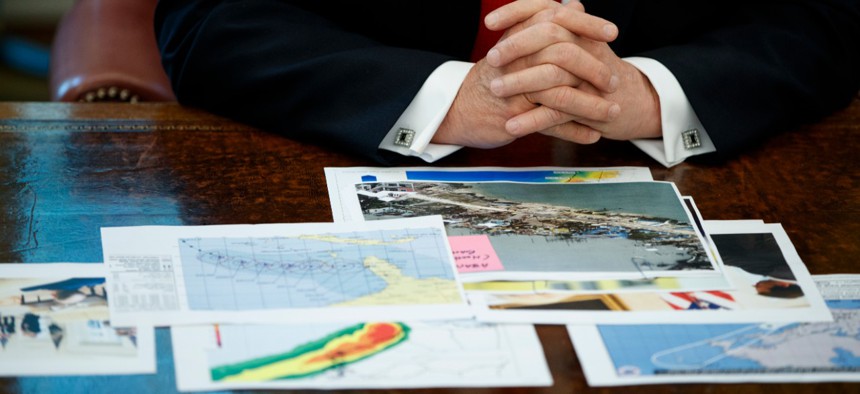
Trump talks with reporters after receiving a briefing on Hurricane Dorian in the Oval Office on Sept. 4. Evan Vucci/AP
Analysis: NOAA Politicized the Weather Report
The scientific agency sided with the president’s inaccurate forecast over the work of its professional staff.
The National Oceanic and Atmospheric Administration (NOAA), a powerful U.S. scientific agency, took the unprecedented step Friday of criticizing one of its own meteorologists for publishing an accurate weather forecast.
In doing so, NOAA effectively politicized the weather report, taking the side of President Donald Trump over that of its own professional scientific staff. It did so with a brief statement, published at the end of the work day Friday, that was not signed by Neil Jacobs, NOAA’s acting administrator.
The story began on Sept. 1. As Hurricane Dorian ravaged the Bahamas, President Trump tweeted, “In addition to Florida—South Carolina, North Carolina, Georgia, and Alabama, will most likely be hit (much) harder than anticipated.”
But this wasn’t true: Dorian would likely miss Alabama entirely. About 20 minutes later, the National Weather Service’s office in Birmingham rushed to correct the record. “Alabama will NOT see any impacts from #Dorian. We repeat, no impacts from Hurricane #Dorian will be felt across Alabama,” it tweeted. “The system will remain too far east.”
What then happened was that Hurricane Dorian did not strike Alabama—and the state certainly wasn’t “hit (much) harder than anticipated.”
But as my colleague David Graham has written, Trump has spent a week bizarrely explaining why he was correct to warn the state’s residents. Thursday he presented a National Hurricane Center map that was obviously doctored with Sharpie to journalists in the Oval Office.
Yet NOAA has now sided with the president. “From Wednesday, August 28, through Monday, September 2, the information provided by NOAA and the National Hurricane Center to President Trump and the wider public demonstrated that tropical-storm-force winds from Hurricane Dorian could impact Alabama,” its statement said. “The Birmingham National Weather Service’s Sunday morning tweet spoke in absolute terms that were inconsistent with probabilities from the best forecast products available at the time.”
This statement is extremely closely written. And NOAA leadership did find a single forecast tool that indicated a small part of southeastern Alabama faced a 5 to 10 percent chance of experiencing 40-mph winds.
Yet this is beside the point, because Alabama never actually experienced those winds. In the course of this week, winds in Alaga—a town in the state’s southeasternmost corner—never exceeded 9 miles an hour, according to the weather-almanac database Dark Sky.
And if NOAA is in a mood to nitpick: President Trump’s statements disagreed far more with “probabilities from the best forecast products available” than the Birmingham office’s did. At no point was Alabama “most likely [to] be hit (much) harder than anticipated.” And this is not even the most egregious example. “They actually gave that a 95 percent chance probability. It turned out that that was not what happened,” Trump said Thursday. The National Weather Service never forecast that Dorian had a 95 percent chance of hitting Alabama.
I have ignored this story for the past few days, figuring that the president’s bizarre behavior should not distract from the U.S. government’s overall skilled preparation and handling of a historically dangerous hurricane. But this statement has turned what has become a routine type of political story (the president has said something misleading!) into one that’s slightly more Soviet—and much more worrying. Americans have gotten used to living in a country where partisanship is unavoidable. But living in a country where a weather report is sometimes partisan and untrustworthy—that’s something new.
NEXT STORY: Don’t Fall Into This Leadership Trap







